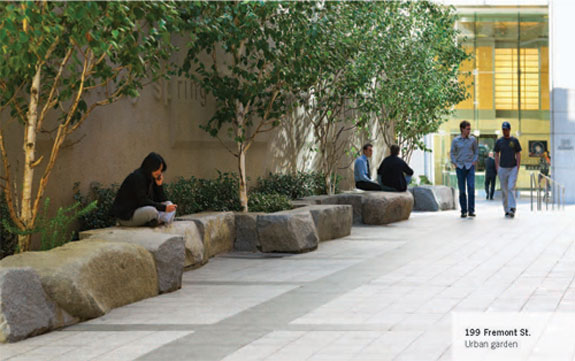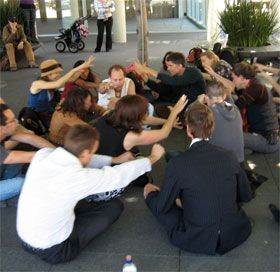Unlocking San Francisco’s Privately Owned Public Open Spaces
12:12 PM PST on January 20, 2009

The shortage of public spaces in San Francisco’s downtown has long been compounded by the fact that the urban geography of privately owned public open spaces (POPOS) makes them hard to find and even harder to enjoy. The San Francisco Planning and Urban Research (SPUR) last week released a report that details all of downtown’s POPOS, complete with a printable map [PDF], and makes recommendations on how to improve access and amenities.
San Francisco’s first privately owned, publicly accessible park was constructed at the base of the Transamerica building in the late 1960s. At that time, building codes neither required nor encouraged development of public space at street level, and accordingly most office towers were built right to the edge of the property. The few exceptions were in buildings where developers sought density and height bonuses and created public space as a condition for approval.
In the 1985 Downtown Plan the city codified the conditions under which developers had to construct publicly accessible open spaces, which could be as diverse as plazas, greenhouses, or atriums, but had to comply with standards of landscaping, design, seating, and bathrooms. Yet, the city made no effort to provide information about the plazas in aggregate.
In 2006, with a grant from Southern Exposure Gallery, the art and public space collective Rebar started COMMONspace, an effort to explore POPOS and encourage public participation in them.
“Here was a territory that existed for which there was no map,” said Rebar’s Blaine Merker. “We kept seeing little plaques that said these were public spaces, but you had to go past security guards and up elevators to get to them. We felt that art could be a form of urban research, but we needed to create art that was equally as absurd as the spaces.”
After identifying more than a dozen POPOS, Rebar led tours and "paraformances" in them, from kite flying to Balinese Kecak monkey chanting. On more than one occasion, they were confronted by unhappy building managers.
On July 21st, 2007, with ACLU legal observation, the Rebar tour was threatened with arrest by the security guards at Foundry Square, 500 Howard St.
After Rebar’s legal representative encouraged the security guard to call the SFPD, saying they were willing to be arrested while monkey chanting, the security administration from Foundry acknowledged the SFPD had sided with Rebar’s interpretation of the space and would not respond to the call.
The ACLU believed the event to be precedent-setting and legally significant for opening up POPOS should there be future efforts to prevent public access.
“The security guards not only didn’t know it was public space,” said Merker, “but were actively telling people to get out.”
Building off of Rebar’s COMMONspace project, SPUR convened a task force of artists, public space advocate s, former planners who had developed The Downtown Plan, and current city planners to review the rules and regulations governing POPOS. They visited all the POPOS, determined which had been constructed before and after 1985 and established standards for evaluating their success as public spaces.
"We found it very interesting to think of what the rights of users and owners of the spaces are," said SPUR project leader Sarah Karlinsky. "The city hasn't done a great job of tracking how POPOS are used and enforced. We were interested in getting the public involved as a vested interest--the Friends of POPOS idea from the report--so that the spaces can't be taken away."
SPUR makes numerous recommendations for improving the public’s experience of existing POPOS, including better signage, better maintenance of the facilities, more seating, and cleaner bathrooms, as well as standards that should be required for the construction of future POPOS. The report concludes:
Privately-owned public open spaces are a key component of our downtown open space network. There are many steps we can take to improve and make better use of these important spaces. Given the changing role of our downtown core, our future open space needs may not be the same as those in years past. It is up to us to build on our past successes to make sure that the next generation of downtown open spaces helps us create a better San Francisco.
In addition to providing the excellent walking guide of POPOS, SPUR will be hosting a walking tour of the spaces on January 28th, 2009 with two city planners who worked on the 1985 Downtown Plan.

Photos: SPUR, Keith Baker, and SoEx from Flickr
Stay in touch
Sign up for our free newsletter





